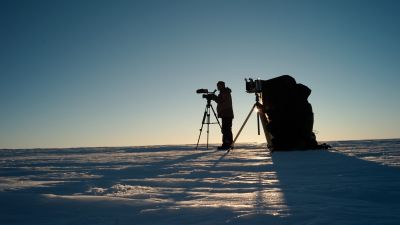
Coastal Reconnaissance
Alain Hubert, René Robert, Kristof Soete and René Wagemans were part of the coastal reconnaissance team which left for Breid Bay on November 28th and returned to the Utsteinen base camp on December 11th. The mission of the reconnaissance team is to ensure and prepare the Ivan Papanin ship's unloading site, and to locate the transport route which will be followed to haul the containers from the coast to the Station. A trip to the coast is 190 km and an 18-hour drive inside a Prinoth tractor. The news is very good: the unloading site is ready for the ship's arrival.
-
The atmosphere on a traverse, a sequence of appreciation.
© International Polar Foundation / René Robert
-
Ahead is South, in our back is North. It is 1 am and we are on a traverse.
© International Polar Foundation / René Robert
-
Catabatic winds as seen from the sky. The crevasses' chicanes were still signalled by bamboos.
© International Polar Foundation / René Robert
-
Arrival at Crown Bay: Tough luck: the 40 ft bungalow has, during the winter, been turned over and carried to the " beach " a hundred metres away. Try to image the breeze around here... but nothing resists the 500 horsepower Prinoth tractors! We were able to sleep in our a little shelter with our heads the right way up and our feet the right way down.
© International Polar Foundation / René Robert
-
View of the Ocean from Breid Bay
© International Polar Foundation / René Robert
-
Arrival at Crown Bay
© International Polar Foundation / René Robert
-
View of the Ocean from Breid Bay
© International Polar Foundation / René Robert
-
View of the Ocean from Breid Bay
© International Polar Foundation / René Robert
-
Conceptual art from Far South: Lay-out of the containers, a metaphor on the victory of shape over content, on the ambient vacuity regarding the loss of meaning which characterises our post-modern civilisation in the beginning of this century.
© International Polar Foundation / René Robert
-
The parking. Just kidding, it's the Antarctic Aliens' nursery!!!
© International Polar Foundation / René Robert
-
Spotting the unloading site at Crown Bay. The iceberg in the shape of a crown is still there. Three weeks from now, the site will be swarmed with activity!
© International Polar Foundation / René Robert
-
At the very end of Crown Bay, Alain is measuring the thickness of the sea ice along the edge of the water. This year, the ice is about 2.2 m thick.
© International Polar Foundation / René Robert
-
Reconnaissance team. Traditional-style work using bamboos. It's the best way. "Ok René, you're holding the rope right!?!"
© International Polar Foundation / René Robert
-
Reconnaissance using bamboos
© International Polar Foundation / René Robert
-
Reconnaissance using bamboos
© International Polar Foundation / René Robert
-
Unloading ramp. The ramp is fundamental to our access to sea ice. It is a natural solution to all of our problems. It is in excellent condition this year!
© International Polar Foundation / René Robert
-
The open water, a few kilometers away from the ramp. The crown is in the background. Crown Bay was formed by a riff: the drift of the ice opened up by a crevasse on the continent, in which the open water is devoured.
© International Polar Foundation / René Robert
-
Working on the surface in Crown Bay. The ice blocks in the middle have fallen from the edges and toppled over by the water during the winter freeze up.
© International Polar Foundation / René Robert
-
Working on the surface
© International Polar Foundation / René Robert
-
Working on the surface of the two routes which will be used to unload the Ivan Papanin ship.
© International Polar Foundation / René Robert
-
Vesthaugen under a blue sky, as seen during the traverse on our way back.
© International Polar Foundation / René Robert
-
Vesthaugen. The thin line of light is a hall of wind: the snow particles are lit up by the low sun rays of 2 am. Returning traverse.
© International Polar Foundation / René Robert






















